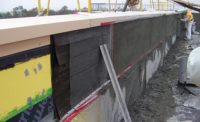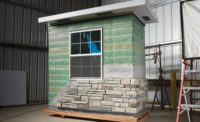Five things to consider in regards to waterproofing products that will help your business—and point to the future.
The start of a new year always serves as a good reminder to take a step back from the daily grind, to analyze what is working well and what is not, and to seek new opportunities to capitalize upon in the coming 12 months. Beyond scrutinizing your own operations, it is also helpful to consider industry trends that might affect your business in the New Year.
So, what trends can we in the waterproofing profession expect in 2018? If you know where to look for the right data, you do not need a crystal ball to make a few solid predictions. Based on what we are seeing in the industry today, as well as the economy at large, we can expect to see the following five trends play out.
1. Satisfy a Need for Speed
One constant in the construction industry is pressure to get more accomplished in less time—often with fewer resources. This will be especially true in 2018, when it is reasonable to expect that new construction spending will continue to increase. According to the latest seasonally adjusted statistics from the U.S. Census Bureau, the value of both non-residential and residential construction put in place in the U.S. has been on the rise for at least six months, and the U.S. Department of Commerce reported an all-time high of $1.257 trillion in construction spending for November 2017. As a result, the pressure on contractors to maximize productivity and reduce application times will continue as demand for laborers and faster construction sequencing grows.
What does this mean for the industry? It means waterproofing contractors will need all the help they can get maximizing man hours and minimizing the time their part of a construction job takes. The good news is that there are products on the market today that can help in this regard.
Consider, for example, a below-grade concrete waterproofing application. Traditionally, contractors have needed to wait up to 30 days for concrete to cure out prior to application of a waterproofing product; but today, there are new products such as Colphene LM Barr—a single-component, high-solids-content, first commercially available liquid-applied silyl terminated polyether (STPE) waterproofing membrane—that can be applied to concrete just seven days after the concrete is installed. As a result, general contractors can spend about a quarter of the time they would otherwise spend waiting to apply waterproofing material, improving their chances of staying on schedule.
Faster cure times are important not only for construction materials like concrete, but for the actual waterproofing materials being applied, as well. Rapid-curing products are entering the marketplace, speeding up construction sequencing across a variety of applications.
Whereas some products take up to two weeks to cure before other material can be applied, choosing a faster-curing product, like a spray-grade STPE membrane, could save contractors a week on the overall construction timeline.
In a horizontal waterproofing application like a hotel balcony, the right polymethyl methacrylate (PMMA)-based product, could take less than a day to cure versus three to five days for traditional products with multistep cure outs. Add that kind of time savings up over dozens or hundreds of balconies, and that makes a big difference.
2. Make Life Easy
Another area to continue watching is labor force turnover as applicators retire and the overall labor force becomes younger and less experienced, adding to challenges related to the general labor shortage problem our industry has been all too familiar with in recent years. According to various studies, finding qualified workers emerged as the most likely issue to impact building envelope contractors in 2018, with 90 percent of respondents expressing concern about this topic.
As waterproofing firms seek to fill labor gaps however they can, we are likely to continue seeing the general level of experience of the waterproofing labor force trend downward. As a result, it is increasingly important that contractors use products and processes that can empower applicators to be successful while still achieving strong results, even if they are new to the industry. One-part, high-solids spray products offer significant advantages for those seeking simple, easy-to-use products.
3. Learn to Love Liquids
We are seeing a consistent trend toward the embrace of liquid-applied waterproofing membranes across the industry. For instance, PMMA-based, rapid-setting, liquid-applied products exhibit dramatically faster cure times and protect walls, balconies and terraces admirably from water, but they are simple to use for an inexperienced applicator. The same goes for quick-curing STPE-based below-grade liquid waterproofing products. As an added benefit, these topcoats are all seamless by nature, decreasing likelihood of water infiltrations.
Because of their ease of application, liquid products are ideal for use in cities where labor costs are high, and it is not always feasible to stage traditional equipment on high-rise buildings. PMMA-based liquid products also benefit contractors by being easy to tint or texture, making them ideal for use in higher-end building projects where appealing aesthetics are key.
Liquid-applied products also hold promise for use with tie-ins between various waterproofing layers within a building. They are compatible with many wall air or vapor barriers, waterproofing systems, making them an ideal choice. This is especially true given liquid products’ seamlessness, flexibility and usefulness for working around cracks and joints.
4. Double-down on Two-component Systems
Two-component waterproofing systems are also growing in popularity as the industry progressively embraces polyurethane, polyurea and other two-part chemistries. In above-ground waterproofing applications, fast chemical cures facilitated by two-component systems are allowing year-round application of waterproofing membranes. For example, a product like liquid-applied Alsan RS can cure in below-freezing temperatures, expanding the working season for some contractors. While a below-grade waterproofing installation generally benefits from use of a moisture-curing system, chemical-curing products are expanding opportunities for contractors working above ground.
5. Mind Your Environment
A final continuing trend to watch is the prevalent demand for environmentally friendly products. Whether contractors are working in areas where VOCs are heavily regulated or not, a desire for environmentally friendly products is ever-growing. Expect to see further emphasis on use of increasingly valuable low-VOC products as a result. On a related note, recognize that there is significant demand for low-odor products—especially in sensitive applications like occupied schools, hospitals and so forth—which will also drive demand for high-solids-content, low-VOC products in 2018.
No matter what this year has in store for you, be sure to think through how macro trends like these could affect your business. For the most part, you can expect to see a continuation of trends that emerged in 2017, but keep in mind the ways in which new products hitting the market could benefit your business by accelerating your productivity and minimizing your costs in the process. If you ever have any questions about how to achieve those goals, reach out to suppliers who can help you find the ideal products to make the most of the opportunities you discover in 2018.









Report Abusive Comment